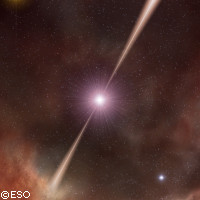Massive gamma ray burst was aimed at Earth, astronomers reveal
Earlier this year, telescopes around the world witnessed the brightest explosion ever seen. Now an international team of astronomers reveals that the explosion was in fact a gamma-ray burst in a distant galaxy halfway across the visible universe that sent a powerful jet of material towards the Earth. 'We conclude that the burst's extraordinary brightness arose from a jet that shot material almost directly towards Earth at almost the speed of light,' said Guido Chincarini of the University of Milano Bicocca in Italy. The event gave astronomers an unprecedented view of a gamma-ray burst, and the observations made in the aftermath of the explosion have revolutionised our understanding of these events. It all began on the morning of 19 March 2008. In Chile, the European Southern Observatory's TORTORA telescope and Poland's 'Pi of the Sky' telescope detected a bright flash in the direction of the Boötes ('the Herdsman') constellation. High above the Earth, NASA's SWIFT satellite detected a burst of gamma rays from the same source. Within seconds, SWIFT sent out an alert and soon numerous telescopes around the world had turned their gaze towards the event. Barely an hour after the first flash was observed the ESO's Very Large Telescope (VLT) revealed that blast was 7.5 billion light years away: halfway across the visible universe. Even at that distance, the explosion was so immense that it could just about have been seen with the naked eye, had anyone been looking in the right direction. Had a similar explosion taken place in our own galaxy, the resulting flash would have been as bright as the sun. Gamma-ray bursts (GRBs) are created when massive stars run out of fuel and collapse to form a black hole. When this happens, powerful jets are forced outwards. These jets travel close to the speed of light. As they streak away from the star, these jets collide with and heat up gas that has previously been shed by the star. The resulting emissions are known as the afterglow. In the seconds, days and weeks following the explosion, the world's astronomers observed this process in great detail. By sharing information, they were able to piece together exactly what happened and thereby boost our understanding of gamma ray bursts. What made this GRB so special was the fact that it was pointing directly at our planet. This view revealed an extremely narrow, ultra-fast jet surrounded by a wider, slightly slower jet. 'Perhaps every gamma-ray burst has a narrow jet, but astronomers miss it most of the time,' commented Stefano Covino of INAF-Brera in Italy. 'We happened to view this monster down the barrel of the very narrow and energetic jet,' added his colleague, Cristiano Guidorzi. 'We normally detect only the wide jet of a GRB as the inner jet is very narrow, equivalent to not much more than one hundredth the angular size of the full moon,' explained Swift team member Dr Paul O'Brien of the University of Leicester in the UK. 'It seems that to see a very bright GRB the narrow jet has to be pointing precisely at the earth. We would expect that to happen only about once per decade. On March 19th, we got lucky.' 'This was the most powerful event ever seen in human existence,' concluded Professor Alex Filippenko of the University of California at Berkeley in the USA. 'A star that blew up and could be seen - barely - with the naked eye [...] even though [it was] seven and a half billion light years away, is just astonishing.'



